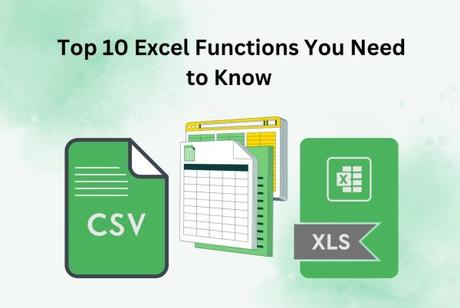
Learning MS Excel in today’s scenario helps you to arrange, analyze and to share data effectively and make your tasks easier. Also, it lets you to convert large datasets into an insight and helps in the fields like data analytics and data management.
But do you know What is Function in MS Excel and how does Excel Functions make your work easier for data management, data and business analytics? If not, then consider joining Excel Training for mastering in Excel functions, formulas and for various data visualisation features.
To learn more about Excel Functions, this blog will discuss the most important 10 Excel functions. Also, understanding the difference between formulas and functions in Excel is useful to use the functions effectively in Excel.
Table of Contents
- What is Function in MS Excel?
- Why do You Need to Know These Functions?
- Difference Between Excel Formula and Function
- Top 10 Excel functions
- Conclusion
What is Function in MS Excel?
Functions in MS Excel are predefined formulas that carry out calculations by using an argument in a specific order or form. Functions are used to carry out easy as well as complex calculations, and you can get all Excel functions and syntax in the formulas tab.
Why do You Need to Know These Functions?
By knowing some basic and important Excel functions and syntaxes, you can easily perform calculations in Excel. Also, functions in Excel help to handle large amounts of data at a time and save the user time, and there is no need to remember the full equation; if you just enter the function, it shows a syntax. By using that syntax, you can easily get answers and apply formulas.
Difference Between Excel Formula and Function
Both formulas and functions are important in MS Excel. But the main difference is functions are predefined and formulas are defined as a statement, or equations created by a user in MS Excel.
Top 10 Excel functions
These are the most common and important functions in Excel that you need to know while working on it.
SUM Function: SUM function adds all the values in a range of cells.
Syntax: SUM (number1, [number2], ….)
IF Function: IF function compares two values and returns either TRUE or FALSE based on the output.
Syntax: IF (logical_test, [value_if_true], [value_if_false])
MIN and MAX Function: MIN Function returns the smallest number in a selected range and ignores logical values and text.
Syntax: MIN (number1, [numbre2], ….)
MAX Function returns the largest number in a selected range and ignores logical values and text.
Syntax: MAX (number1, [numbre2], ….)
AVERAGE Function: AVERAGE function returns the average of the selected range. E.g. names, numbers, cell references or arrays.
Syntax: AVERAGE (number1, [numbre2], ….)
CONCAT Function: CONCATENATE function joins two or more list or range of text strings.
Syntax: CONCAT (text1, …)
COUNT Function: COUNT function counts the number of cells in a range that contain numbers.
Syntax: COUNT (value1, [value2], …)
COUNTA Function: COUNTA function counts the number of cells which contains numbers, text, logical values, and error values. Ignores empty cells.
Syntax: COUNTA (value1, [value2], …)
COUNTIF Function: COUNTIF function counts the number of cells which meets the specific criteria.
Syntax: COUNTIF (range, criteria)
VLOOKUP Function: Looks for a value in the leftmost column of a table, and then returns a value in the same row from a column you specify.
Syntax: VLOOKUP (lookup_value, table_array, col_index_num, [range_lookup])
INDEX and MATCH Function:
INDEX function returns the value in a range or array based on the row and column numbers you specify.
Syntax: (array, row_num, [column_num])
MATCH Function: MATCH function returns the relative position of an item in an array that matches a specified order.
Syntax: MATCH (lookup_value, lookup_array, [match_type])
Conclusion
By understanding the functions in Excel, users can enhance their data analysis and visualisation skills effectively. Data management efficiently occurs if you know the features of Excel. Joining Excel training or courses helps you understand more features, including formulas and functions of Excel. Driving efficiency and productivity in various professional settings is possible when you know functions in Excel.

